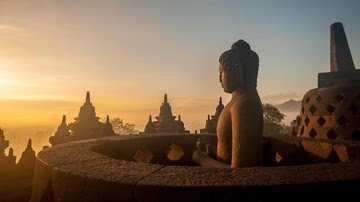The architectural splendor of Borobudur Temple cannot be separated from the long history of the development of Buddhism in Indonesia.
The fame of Borobudur Temple is well known to foreign countries and is known as the largest Buddhist monument in the world according to the Ministry of Tourism website. Located in Magelang, Central Java, Borobudur Temple underwent a long period of restoration to restore its majesty. Borobudur Temple is one of the most valuable treasures in Indonesia and the world. The following is a review of the history of Borobudur Temple and its unique facts
A Brief History of Borobudur Temple According to historical records, the initial construction of Borobudur Temple occurred in the 8th and 9th centuries around 800 AD during the reign of the Syailendra dynasty.
The shape of the Borobudur Temple As the largest Buddhist temple in the world as well as the largest Buddhist monument in the world, according to the Ministry of Education and Culture website, Borobudur Temple has a structure like a punden terrace which is getting smaller with four stairs located in each cardinal direction.
Borobudur Temple has a length of 121.66 meters with a width of 121.38 meters and a height of 35.40 meters. According to Buddhist philosophy, the level structure of Borobudur Temple is an imitation of the universe for the wheel of life. There are three levels in the structure of the Borobudur that is Temple:
Kamadhatu: The lower part of the temple which symbolizes the underworld, describes human behavior that is still bound by worldly desires. Rupadhatu: The middle part of the temple which symbolizes the intermediate nature, describes the behavior of humans who have started to leave worldly desires, but are still bound by the real world. Arupadhatu: The upper part of the temple which symbolizes the upper realm, depicts the intangible element and as a sign of the level that has left worldly desires.
The stones in Borobudur Temple are predicted to come from rivers around Borobudur with a total volume of about 55,000 cubic meters, equivalent to 2 million pieces of stone.
Functions of Borobudur Temple Apart from being a tourist place, Borobudur Temple now functions as a place of pilgrimage for Buddhists worldwide to guide humanity from worldly desires to enlightenment and wisdom according to Buddhist teachings.
On the way, pilgrims walk through a series of hallways and stairs by witnessing 1,460 reliefs engraved on the stone walls of the temple.Unique Facts about Borobudur Temple In addition to the history and moments of the Vesak day that attracted foreign attention, Borobudur Temple keeps a number of unique facts including:
There are 2,672 relief panels and 504 Buddha statues, making Borobudur the owner of the longest and most extensive Buddha reliefs in the world.
Theft of statues is rampant. Real Buddha head statues are often stolen and then sold in antiques, collectors and illegal markets. Of the 504 Buddha statues, many were found in a headless condition.
Borobudur Temple was bombed. Two years after the 2nd restoration, January 21, 1985, 13 bombs were placed by the perpetrators in a number of small stupas. 9 of the 13 bombs exploded and destroyed hundreds of stone blocks of the stupa. The bombing action is related to radical understanding. The Dutch East Indies government handed over the precious statues to Thailand and England.
The Dutch East Indies government at that time gave free temple artifacts in large quantities as a gift for the arrival of the Thai King Chulalongkorn II.
The Dutch East Indies government had established a coffee shop at the top of the stupa when it was first discovered.
and now Borobudur Temple is closed during the Covid19 pandemic.
.jpeg)


I hope Covid19 passes quickly and for all of you take care of your health, don't forget to wear masks, keep your distance to avoid the spread of the Covid-19 virus.
Thank you.